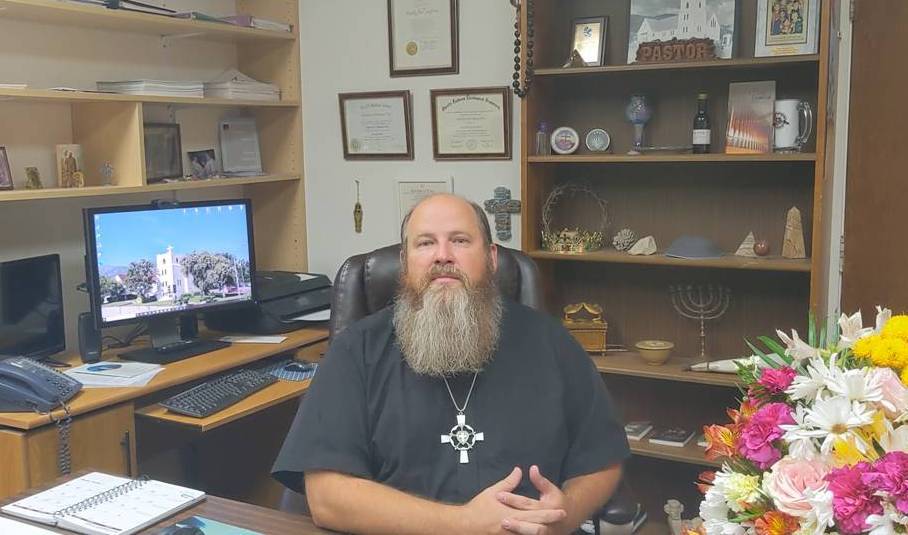Recently during our online Bible study of the Book of Ephesians, hosted on the Zoom video conferencing platform, we discussed the “holy temple” of Ephesians chapter 2…
So Christ came and proclaimed peace to you who were far off and peace to those who were near; for through him both of us have access in one Spirit to the Father. So then you are no longer strangers and foreigners, but you are citizens with the saints and also members of the household of God, built upon the foundation of the apostles and prophets, with Christ Jesus himself as the cornerstone. In him the whole structure is joined together and grows into a holy temple in the Lord; in whom you also are built together spiritually into a dwelling place for God.
Ephesians 2:17-22
As I shared with the other Bible study participants on Zoom, this image of the Church of Jesus Christ as one living temple is a favorite biblical image for me. Of course the Bible uses several other images to describe the Church, such as one living body with many different members, or as one living tree into which we (many different branches) are grafted by God’s grace. However, the image of a living temple speaks to my heart a little bit more than these others.
As a lover of architecture, the living temple image of the Church in Ephesians allows me to imagine the various interrelated structural parts — including how we might imagine our relationship with the Holy Trinity of God. Therefore, with the apostles and prophets of the New and Old Testaments as the foundation of this great spiritual temple, and with ourselves as its living interconnected stone blocks, let’s focus on the three most notable pieces of stonemasonry: the Cornerstone, the Keystone, and the Capstone.
The cornerstone (or setting stone) is the first stone placed in a masonry construction, and all the other building stones will be set in reference to this first stone — thereby determining the overall position of the entire structure. Likewise, Jesus Christ is our divine Cornerstone, the chief stone set in place for us to base our individual orientation within the overall temple structure. In other words, our Lord Jesus’ life, teachings, death and resurrection give us the exact spiritual dimensions that we use to set and position our faith and spirituality.
The keystone (sometimes doubling as a capstone) is the central wedge stone at the apex of a masonry arch, or it’s the circular wedge stone at the apex of a vaulted structure. In both cases it’s the final stone that locks all the stones of an arch or vault into position, allowing the arch or vault to bear the weight of the surrounding structure. Similarly, the Holy Spirit is our divine Keystone, the central wedge stone that unites and binds all the other stones into one load-bearing temple structure. Consequently, due to the open but solid archway of the Holy Spirit (or Holy Keystone) we are strengthened and kept in true faith by the Holy Spirit’s power and spiritual gifts, bestowed upon us through the Word and Sacraments of God.
The capstone (sometimes doubling as a keystone) is a stone placed at the pinnacle of a masonry construction, typically on top of a wall or a monument. In addition, the capstone is an architectural feature that is often found at the very top of religious, memorial and governmental structures. As a result, capstones on such structures as these are often detailed artistic features placed at the highest point in order to indicate the purpose or meaning of the entire building. Furthermore, the capstone can be circular or conical or pyramidal in shape.
On both governmental and religious buildings, the capstone can often have some kind of decorative orb centered on top — and this orb can also have a symbol or statue on top of it. For example, there is an ornate capstone at the pinnacle of the dome of our United States Capitol Building, and it’s a conical-shaped capstone supporting an orb (etched with the words “E Pluribus Unum”) that also has the Statue of Freedom standing upon the orb. Or for another example, centered on the capstones of many Church cathedrals there are orbs with either cross symbols or angelic figures (or both). Likewise, just as it is with these beautiful capstone structures on top of large governmental and religious buildings, our Heavenly Father is our divine Capstone, the pinnacle stone that indicates our highest purpose and meaning, and our highest exultation and destiny.
As we are physically isolated during this global Coronavirus pandemic and national quarantine, it is deeply important that we remember our spiritual togetherness as stones in God’s living temple — securely interconnected with God and each other forever by God’s amazing grace. With the Father, Son and Holy Spirit (our divine Capstone, Cornerstone and Keystone), and with the apostles and prophets as our foundation, we shall stand firm throughout it all.
Lastly, with all of this in mind, I’m reminded of the first part of the third verse of the great Christian hymn “Built on a Rock the Church Shall Stand”…
Christ builds a house of living stones:
we are his own habitation;
he fills our hearts, his humble thrones,
granting us life and salvation.
Evangelical Lutheran Worship (ELW), Hymn #652, Verse 3
A blessed Pentecost Sunday to all of you in May and a wonder-full Holy Trinity Sunday in June!
Together in God’s Living Temple, Pastor Tim

